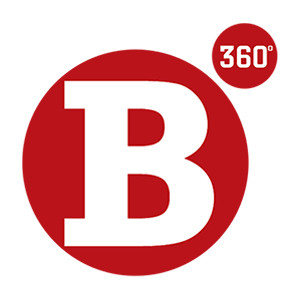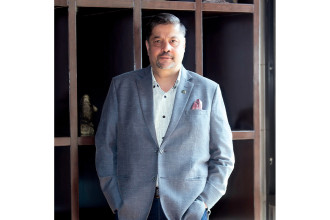-1719725649.jpg)
A Swiss business delegation was in Nepal to participate in a second fact finding mission in March aimed to acquaint Swiss companies with the Nepali market and its key players. It was held, was organised by the Embassy of Switzerland in collaboration with Switzerland Global Enterprise and the Nepal Swiss Chamber of Commerce and Industries.
Business 360 met up with Brandon Mathews, Chief Executive Officer of Stonestep, who was a part of the delegation. Stonestep is a company founded in 2012 and based in Switzerland that simplifies insurance processes for companies and their clientele, minimising costs and risks. With a focus on high-volume risk transfer, it processed over 70 million new policies in 2023. Its platform model facilitates easy and cost-effective implementation of insurance solutions for various sectors like finance, supply chain NGOs and ecommerce. Stonestep’s approach includes ready integrations for climate and health risks, along with unlocking traditional insurance categories for swift enrollment of new users. Beyond selling insurance, Stonestep aims to enhance livelihoods by mitigating actual exposure to loss.
Excerpts of our conversation with Mathews:
Could you tell us a bit about Stonestep’s business model and how it aligns with the needs and opportunities of Nepal’s insurance sector?
StoneStep has evolved significantly since its inception. Initially, we functioned as a consultancy, leveraging my experience in the insurance industry, particularly mass and micro products. While successful in delivering projects, I gravitated towards building solutions rather than solely advising. This led us to transition into an insurtech intermediary model, akin to a super-agent or broker. We have since progressed further, becoming an enabler or venture developer.
We have been in Nepal since 2017. Our core mission lies in making insurance affordable and accessible, particularly in remote areas like the Karnali River Valley. Technology plays a crucial role in streamlining processes and reducing costs. We bridge the gap between local villages and established insurers, ultimately facilitating the transfer of risk from Nepal to the global reinsurance market. In essence, we connect the underserved with reputable insurance providers. This time, I am here to connect with more people.
What motivated you to enter the Nepali market?
Initially, a large existing client brought us into the insurance space in Nepal. But our continued presence stems from a deeper purpose. Here’s why. Firstly, the need for better and more accessible insurance is undeniable. Nepal’s insurance penetration reflects broader market trends, but the need itself is far greater. Just like seeing life insurance costs incentivises smokers to quit, fair pricing is crucial for behaviour change. Climate change is another pressing issue requiring adaptation, and accurate pricing empowers people to make necessary adjustments. We are committed to providing these fair prices to bridge the gap. Our focus has shifted to the commercial aspect, ensuring that insurance is not just accessible but also desirable. We want people to view it as a contingency savings plan, not an expense. This shift in perception is key; it is about saving for a potential future need, not simply adding another cost.
In Nepal, the insurance sector faces challenges of both accessibility and affordability. How do you intend to address these?
Western insurance models, like the employer-based system established by Bismarck in Germany way back in 1873, work well in developed markets. Here in Nepal, though, 70% of jobs are informal or small businesses. This existing structure doesn’t translate because there are no large employers to anchor insurance plans.
So, who else has a stake in protecting people, beyond just profit? Local institutions like cooperatives. Banks are limited, but mobile wallets and operators offer potential for cost-effective solutions. The key is integrating insurance into these local systems, as it’s not a one-time purchase but a long-term need. We are currently working with cooperatives to build this framework; a strategy that aligns our goals with the community’s needs.
What’s the strategies to then establish a stronger presence here and to increase the market share?
Forget about market share, for us in insurance, intention is everything. Traditional market share mentality implies capturing and holding something which clashes with our goal of market enablement. We, as a foreign company, can only bring so much to the table. If our solutions aren’t embraced by the local ecosystem, they will either be outcompeted or simply rejected. Our focus is on collaboration – working with industry partners, government, and external investors, including donors and development agencies. The ultimate goal? Figuring out how to efficiently transfer risk, especially climate risk, out of Nepal and onto global markets where it can be fairly priced.
Is there anything that StoneStep is doing differently from other insurance providers in Nepal?
Our role is distinct from traditional insurers. Insurers manage their own capital, while we focus on representing demand. But even that’s not quite accurate; we empower entities like cooperatives and mobile operators to understand the demand for insurance. We show them how financial models work, how insurance products can extend customer relationships, and how to prioritise long-term customer retention over short-term profit on individual sales. This approach isn’t for everyone. Only businesses invested in long-term customer relationships are a good fit for us. It’s not about differentiation; it’s a fundamentally different role. Traditional capital providers focus on supply, but someone needs to champion the demand side. That’s where we come in; enabling the demand for insurance to be effectively met.
As the world embraces digital wallets and other financial technologies, cybercrime is a growing concern. How do companies like yours address evolving cyber threats?
Cybercrime is a hot topic. I recently heard a European insurance company’s CEO express concern about its potential un-insurability due to its unpredictable nature and high costs. Here in Nepal, my focus lies on lower and middle-income segments, who are less susceptible to targeted cyberattacks compared to high net-worth individuals. My priorities lie in more fundamental risks like floods, droughts, and health concerns.
However, a recent study by ING bank revealed a sobering reality; a significant portion of the population in developed economies lack sufficient savings to cover a three-month financial setback. This vulnerability is likely mirrored in Nepal and other developing nations. This is where insurance, both private and government-backed, plays a crucial role. It provides a safety net, allowing people to manage risk by understanding the cost and potentially taking steps to mitigate it.
Take fire insurance. Knowing the cost prompts building owners to install fire alarms, reducing risk and potentially lowering premiums. Similarly, climate risk insurance can incentivise people to relocate from high-risk areas or reinforce their homes. These are the practical benefits of a well-established insurance system, and that’s what we are striving to build; a system that goes beyond theoretical protection and empowers informed risk management.
Which areas of climate induced disasters do you focus on?
Our current focus is on parametric products tied to commodity values. These products rely on objective, measurable data; think satellite imagery or weather stations – to assess risk for a specific location, not an individual. Individuals within that area can then purchase units of this insurance, essentially buying financial protection by the ‘kilo’ based on their needs. A key advantage is the automated claims process. Forget claim forms – if the pre-determined trigger event occurs (e.g., a specific amount of rainfall), payouts are automatically deposited. This simplicity makes it easier to explain and implement, leading to better uptake.
To strengthen Stonestep’s presence in Nepal, what are your company’s plans for future investments, either in terms of market development or direct capital injection?
Investment is crucial for growth, especially in a long-term industry like insurance. We believe the ideal approach is a blend of local and international investment.
International investment brings a comparative advantage – expertise and tools that might be difficult or expensive for local companies to develop on their own. Local investment, on the other hand, is essential for building relationships and navigating the specific market landscape. We are currently facilitating these ventures in Nepal, transitioning from our initial model to this blended approach. It’s a bit of a proving ground for us, demonstrating the effectiveness of this strategy.
A unique aspect of our investment strategy is the focus on research and development (R&D). While traditional venture capitalists may shy away from R&D costs, we actively partner with donor funds. Our philosophy is that solving a significant problem here in Nepal can pave the way for future monetisation, creating a win-win situation.
How do you collaborate with local partners and what are the major challenges in the Nepali insurance market?
Collaboration is key. We speak the language of insurance companies, making negotiations and discussions smoother. However, with demand aggregators like cooperatives and mobile wallets, the approach is different. We need to explain the product’s value proposition, highlighting its benefits and functionalities. Ultimately, they decide whether it aligns with their needs. There is no forceful persuasion; it is a fact-based presentation. Thankfully, our local team led by Sanjay Yadav bridges the gap.
Challenges remain, though. One hurdle was basic payments which we tackled by entering the market early alongside mobile wallets. Thankfully, that infrastructure is now established. However, product awareness and past negative experiences with insurance introductions create new obstacles. We believe transparency in our intentions is crucial. By consistently delivering value through different channels, we are gradually earning trust and making progress.
What risk mitigation strategies does Stonestep employ to navigate the challenges of operating in developing countries like Nepal?
Investment considerations tie into risk management, don’t they? We mitigate physical and health risks through responsible practices and appropriate insurance. But the standard business risks, like competitor strategies, are a constant factor everywhere.
The real head-scratchers are sovereign and macroeconomic risks. However, our core mission transcends these challenges. What we are building in Nepal, with its lower-income demographics can be replicated in places like New York. The true frontier of insurance isn’t geographic; it’s about income level. People like delivery drivers or ride-sharing workers in developed countries often face similar struggles - lack of employer-provided insurance and limited access.
Imagine having a trusted advisor, like a wise uncle who has been in insurance for decades. That is the kind of trust deficit we aim to bridge. Technology helps with speed and cost, but it does not guarantee better products, especially when understanding and trust are paramount. Here in Nepal and other emerging markets, we focus on identifying these ‘trusted uncle’ figures and presenting information in a way that fosters trust. It is an intangible concept, but it is the heart of what we do.






